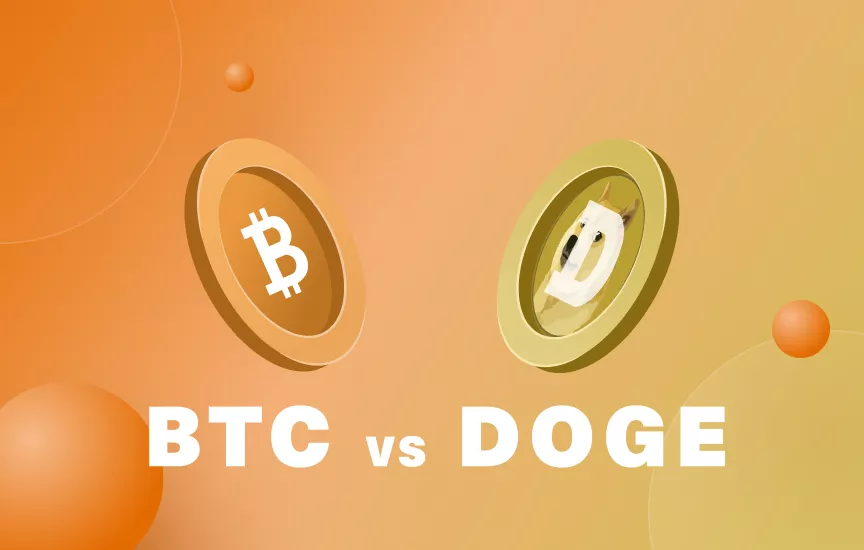Dogecoin vs Bitcoin: Inflation Compared
If you are active in the crypto space, you must have already noticed the difference that each coin showcases. Let’s pick Dogecoin and Bitcoin as an example; both coins seem quite close due to being decentralized, run on blockchain technology, and having communities behind them. However, one thing still sets them apart, and that is their inflation handling.
When inflation is being mentioned, especially in this case, it does not refer to your everyday grocery prices going up. In crypto, it means how much new supply is added to a coin’s circulation over time. And this simple idea significantly determines everything, including investor confidence, to how a coin is used in the real world.
Moreover, most investors and crypto enthusiasts tend to ask, which is better (a fixed-supply model like Bitcoin’s or a steadily growing one like Dogecoin)? Let’s walk through how both work, what their inflation means for users and investors, and why it matters more than most people think, if it does.
Built-in Scarcity of Bitcoin’s Supply
Bitcoin was introduced to act as an alternative to cash, but as a digital asset, with built-in protections to support deflation. One of the key features of the digital currency is that it has a maximum supply which is 21 million coins. In other words, once all of it has been thoroughly circulated, no more will ever be created.
This fixed cap is one of the reasons why the coin is referred to as “digital gold.” The supply is released slowly over time through mining rewards, and every four years or so, there’s a process called the halving, where those rewards get cut in half. This slows the creation of new bitcoins, which in turn makes the coin harder to get over time.
Applying the knowledge of statistics, Bitcoin’s inflation rate has shrunk in the past few years. In 2009, miners earned 50 BTC per block. Now, in 2025, they earn about 6.25 BTC, although this will be halved to 3.125 BTC per block. Looking a few years from now, the number will drop again.
In a nutshell, due to the coin’s scarcity, more people want to buy and hold onto it, hoping for it to gain value as time goes on, making the coin a deflationary asset.
Dogecoin’s Approach: Constant and Predictable Inflation
Dogecoin opposes Bitcoin deflationary as it takes the route of having an uncapped model, which does not limit its supply. What this means is that more coins are added every single year with no end in sight. Around 570,776 new coins are created every hour, which works out to about 5 billion new coins annually.
At first, this might sound like an actual disaster. But here’s the interesting part: the amount added each year does not change, but the percentage of inflation does. As the total number of coins in circulation grows, the yearly increase becomes a smaller slice of the overall pie.
For example, in 2015, Dogecoin’s annual inflation rate was over 5 percent. In 2025, it’s just above 3 percent. And in the future, that number will probably keep falling.
Concluding, we think Dogecoin’s developers didn’t want it to be a coin people hold onto, but rather a digital asset suitable for tipping, for casual use, and fun. The idea was to encourage people to spend it, not stick it in their wallets for years.
How Inflation Affects Each Coin’s Role and Value
This is where things get quite interesting, so do not miss out. The inflation structure of each coin impacts how people treat them, not just in theory, but in real real-life sense. Let’s quickly look at that of Bitcoin.
1. Bitcoin’s Scarcity Encourages Holding
Because there will certainly be no more than 21 million bitcoins, many treat it like a long-term store of value. The idea is just that, if it’s scarce, it should grow in value over time, especially if demand keeps rising. This is why anyone would buy the idea of buying and holding the coin instead of spending it.
2. Dogecoin’s Supply Model Supports Everyday Use
Compared to Bitcoin (BTC), Dogecoin (DOGE) does not aim to be scarce. The steady inflation helps keep its price from quick, volatile movements, making it more practical for tipping, small payments, or even larger transactions that do not need to double in value overnight. This structure supports a healthier flow of coins whereby people send, receive, and keep it moving regularly.
Which Inflation Model Works Best?
Uhmmm, there’s no single right answer here, and if we keep thinking about it, we would always arrive at a possible answer of “it depends on what you’re looking for”.
Let’s consider that you are in for long-term value growth and want something to hold onto like digital real estate, because BTC is the best option due to its deflationary setup being hard to beat.
However, if your interest is drawn towards an easy-to-use digital currency with low fees and fast transaction times, Dogecoin is the right answer in the sense that it has an economic model that keeps the network running smoothly and supports more friendly and casual transactions.
Cheap Remote Crypto Mining for you – Click Here
Conclusion
The difference between these two coins is that Bitcoin is built to be stored and protected, like treasure. Its fixed supply is part of what gives it value. Dogecoin, on the other hand, is designed to be shared, not about scarcity or anything of the sort rather about regular usability.
Neither approach is perfect. And neither guarantees success. Just that, before you decide which one belongs in your wallet, ask yourself if you want something storable or usable, and once you’ve understood how inflation works in both cases, you will see a clearer picture of what each coin is built for.


